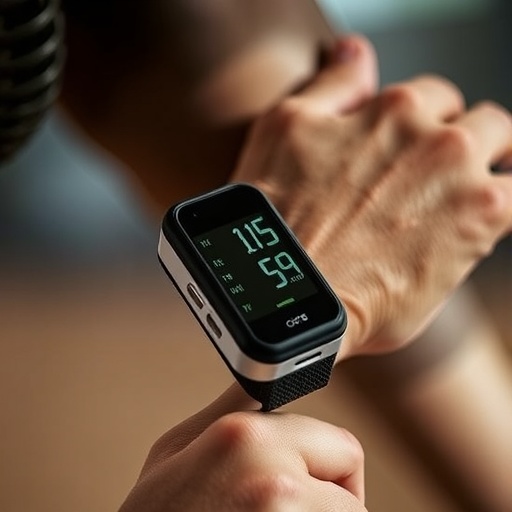A groundbreaking development in health monitoring has emerged from a collaborative effort at Penn State. Researchers led by Huanyu “Larry” Cheng have designed an innovative on-skin sensing platform capable of detecting vitamin B6 in minimal concentrations found in sweat. This advancement is particularly timely, as many patients with chronic conditions, such as diabetes, are prone to vitamin B6 deficiencies, which can significantly impair both mental and physical health. The new technology not only aims to simplify the monitoring of this vital nutrient but also introduces a dual-functionality feature, enabling the simultaneous tracking of glucose levels.
Vitamin B6, recognized for its pivotal role in immune system functionality and neurological health, can be difficult to monitor effectively as traditional methods typically require expensive blood tests. With this new approach, the need for invasive blood draws may soon become obsolete. The developed sensor enables continuous monitoring and presents an opportunity for patients to assess their vitamin B6 status in a non-invasive manner from the comfort of their homes. Researchers have highlighted that regular monitoring could reveal fluctuations in vitamin B6 levels, which are critical indicators of immune system status and overall well-being.
At the heart of this technological marvel lies laser-induced graphene (LIG) nanocomposites, strategically designed to form a high-sensitive probe. This advanced method involves creating a sensor scaffold from atomically thin layers of carbon, serving as a foundation for the integration of multiple functional components targeting specific biomarkers, such as vitamin B6. The innovation does not stop there; the researchers employed molecularly imprinted polymers (MIPs) to specifically latch onto vitamin B6 in the minute quantities present in sweat.
MIPs are engineered to possess pre-defined recognition sites, simulating biological receptors, like antibodies, which interact with target molecules. When introduced to vitamin B6, these imprinted polymers act like artificial enzymes, providing a tailored approach to binding with the specific molecules of interest. This precision enables the detection of vitamin B6 even when present in trace amounts, effectively replacing the traditional and more cumbersome methods of monitoring nutrient levels.
The on-skin sensing platform employs a novel combination of MIPs and Prussian blue redox probes. This fusion not only enhances the detection capabilities of the sensor but also allows for the generation of a measurable electrical signal triggered by the presence of target molecules. With typical vitamin B6 levels in sweat hovering around 100 nanomolar, the sensor achieves sensitivity with a detection limit of just 0.93 nanomolar, a significant advancement in the diagnostics field.
Additionally, the research team extended their focus to glucose monitoring, successfully achieving a detection limit of 93 nanomolar during on-body testing of the sensor. This level of sensitivity is unparalleled when compared to existing glucose monitors in the market, which often struggle with accuracy in non-invasive testing environments. Cheng emphasizes that the adaptability of this sensing platform opens avenues for detecting a variety of other biomarkers, including female reproductive hormones and indicators of infectious diseases such as sepsis.
Continuous monitoring of nutrients like vitamin B6 could be transformative for patient health management. Fluctuations in vitamin levels can serve as warning signs, alerting healthcare providers to potential vulnerabilities, especially for patients suffering from chronic ailments. The timely detection of vitamin B6 deficiency could empower patients to proactively manage their health, potentially adjusting dietary habits or treatments before serious health issues arise.
A considerable amount of research funding has backed this initiative, including support from the National Institutes of Health and the U.S. National Science Foundation, demonstrating the importance of interdisciplinary collaboration in advancing healthcare technology. Furthermore, the implications of this research extend beyond just vitamin B6 detection; they pave the way toward a future where non-invasive, continuous monitoring systems could revolutionize how we track our overall health.
The publication of this research in “Composites Part B: Engineering” signifies a critical step in the trajectory of health monitoring systems. The authors hope to expand upon their findings in subsequent studies, exploring the potential of MIPs and nanocomposite technology to detect other significant health markers.
As chronic conditions, especially diabetes, become increasingly prevalent, innovations like this sensing platform could play an essential role in disease management and overall health improvement. The ongoing evolution of portable, non-invasive health monitoring devices may well become a staple in proactive healthcare initiatives.
Modern technology continues to inch closer to personalized medicine, where everyday health metrics can be monitored in real time, thus informing more tailored and effective interventions. This research could serve as a foundation upon which future innovations are built, further bridging the gap between complex biomedical research and practical, user-friendly health management tools.
By rewriting the narrative surrounding health monitoring, researchers at Penn State are not only advancing scientific knowledge but are also potentially enhancing the quality of life for patients around the world.
As this research and its implications become more broadly understood, the role of interdisciplinary collaboration in fostering groundbreaking health technologies will become increasingly clear, underscoring the importance of investments in scientific research.
With the potential to impact countless lives, the implications of this technology echo a shift in how we perceive health monitoring, emphasizing the vital connection between nutrition, chronic disease management, and innovative technology.
It’s clear that this on-skin sensing platform has the potential to redefine health monitoring paradigms, providing the tools necessary for patients and healthcare providers to stay ahead in managing both dietary health and chronic conditions.
Subject of Research: People
Article Title: Laser-induced graphene nanocomposites with molecularly imprinted polymers and Prussian blue for electrochemical sensing of vitamin B6 and glucose
News Publication Date: 28-Jul-2025
Web References: DOI
References: Composites Part B Engineering
Image Credits: Credit: Provided by Larry Cheng/Penn State
Keywords
Sensors, Health Monitoring, Vitamin B6, Diabetes, Non-invasive Technology, Molecularly Imprinted Polymers.




